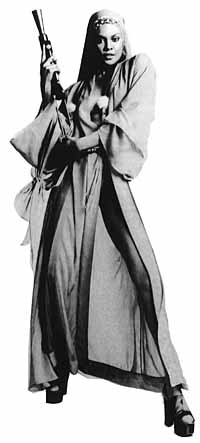


![[Welcome]](../../graphics/content5.gif)
![[Features]](../../graphics/conten4y.gif)
![[In Focus]](../../graphics/content3.gif)
![[Reviews]](../../graphics/content2.gif)
![[Info]](../../graphics/content1.gif)
|

| by Chris Norton -- page 1 of 5
|
|
 The impact of James Bond on all spy thrillers after the release of Dr. No (1962) and the success of Goldfinger (1964) cannot be overstated. The success of Bond was quickly taken up in film, television and literature in an effort to capitalize on 007's success. It is no wonder then that when one looks at one of Hollywood's most glaring examples of appropriation, blaxploitation, one finds the tropes of Bond being so liberally sprinkled about. Cleopatra Jones (1973) and Cleopatra Jones and the Casino of Gold (1975) are two excellent examples of Bond's influence on spy stories. Whether it be the exotic far-flung locales, the excessive weaponry ingeniously concealed, or how Cleo always escapes from the most implausible snares set by her nemeses, the sub-text of Bond is never pushed too far below the surface. Of course as the figurehead of espionage culture, James Bond could not be outdone by an outrageously bedecked black female action hero. In Roger Moore’s first stab at the Bond role, Live and Let Die (1973) finds Bond dispatching a number of voodoo practicing/heroin smuggling black gangsters who wallow in the style made popular by the blaxploitation films. These three films display a remarkably tangled web of Hollywood's co-optation strategies as they apply to race.1 Not only has Hollywood co-opted black aesthetics, themes and images through its blaxploitation genre, but the Cleo films have co-opted Bond, and finally, Live and Let Die has co-opted the tropes of blaxploitation. The impact of James Bond on all spy thrillers after the release of Dr. No (1962) and the success of Goldfinger (1964) cannot be overstated. The success of Bond was quickly taken up in film, television and literature in an effort to capitalize on 007's success. It is no wonder then that when one looks at one of Hollywood's most glaring examples of appropriation, blaxploitation, one finds the tropes of Bond being so liberally sprinkled about. Cleopatra Jones (1973) and Cleopatra Jones and the Casino of Gold (1975) are two excellent examples of Bond's influence on spy stories. Whether it be the exotic far-flung locales, the excessive weaponry ingeniously concealed, or how Cleo always escapes from the most implausible snares set by her nemeses, the sub-text of Bond is never pushed too far below the surface. Of course as the figurehead of espionage culture, James Bond could not be outdone by an outrageously bedecked black female action hero. In Roger Moore’s first stab at the Bond role, Live and Let Die (1973) finds Bond dispatching a number of voodoo practicing/heroin smuggling black gangsters who wallow in the style made popular by the blaxploitation films. These three films display a remarkably tangled web of Hollywood's co-optation strategies as they apply to race.1 Not only has Hollywood co-opted black aesthetics, themes and images through its blaxploitation genre, but the Cleo films have co-opted Bond, and finally, Live and Let Die has co-opted the tropes of blaxploitation.
|
|


